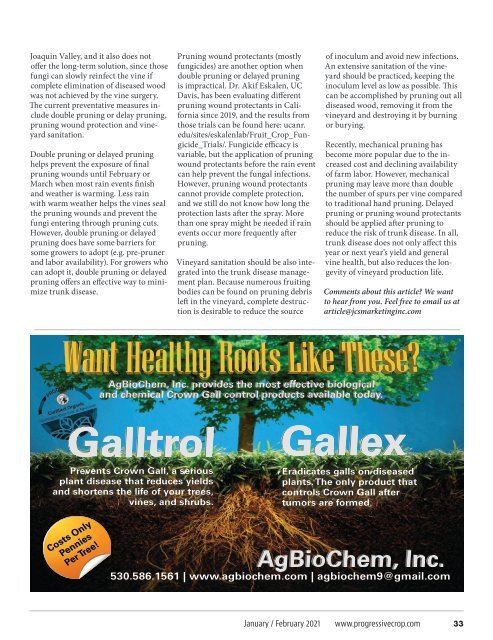Create successful ePaper yourself
Turn your PDF publications into a flip-book with our unique Google optimized e-Paper software.
Joaquin Valley, and it also does not<br />
offer the long-term solution, since those<br />
fungi can slowly reinfect the vine if<br />
complete elimination of diseased wood<br />
was not achieved by the vine surgery.<br />
The current preventative measures include<br />
double pruning or delay pruning,<br />
pruning wound protection and vineyard<br />
sanitation.<br />
Double pruning or delayed pruning<br />
helps prevent the exposure of final<br />
pruning wounds until February or<br />
March when most rain events finish<br />
and weather is warming. Less rain<br />
with warm weather helps the vines seal<br />
the pruning wounds and prevent the<br />
fungi entering through pruning cuts.<br />
However, double pruning or delayed<br />
pruning does have some barriers for<br />
some growers to adopt (e.g. pre-pruner<br />
and labor availability). For growers who<br />
can adopt it, double pruning or delayed<br />
pruning offers an effective way to minimize<br />
trunk disease.<br />
Pruning wound protectants (mostly<br />
fungicides) are another option when<br />
double pruning or delayed pruning<br />
is impractical. Dr. Akif Eskalen, UC<br />
Davis, has been evaluating different<br />
pruning wound protectants in California<br />
since 2019, and the results from<br />
those trials can be found here: ucanr.<br />
edu/sites/eskalenlab/Fruit_Crop_Fungicide_Trials/.<br />
Fungicide efficacy is<br />
variable, but the application of pruning<br />
wound protectants before the rain event<br />
can help prevent the fungal infections.<br />
However, pruning wound protectants<br />
cannot provide complete protection,<br />
and we still do not know how long the<br />
protection lasts after the spray. More<br />
than one spray might be needed if rain<br />
events occur more frequently after<br />
pruning.<br />
Vineyard sanitation should be also integrated<br />
into the trunk disease management<br />
plan. Because numerous fruiting<br />
bodies can be found on pruning debris<br />
left in the vineyard, complete destruction<br />
is desirable to reduce the source<br />
of inoculum and avoid new infections.<br />
An extensive sanitation of the vineyard<br />
should be practiced, keeping the<br />
inoculum level as low as possible. This<br />
can be accomplished by pruning out all<br />
diseased wood, removing it from the<br />
vineyard and destroying it by burning<br />
or burying.<br />
Recently, mechanical pruning has<br />
become more popular due to the increased<br />
cost and declining availability<br />
of farm labor. However, mechanical<br />
pruning may leave more than double<br />
the number of spurs per vine compared<br />
to traditional hand pruning. Delayed<br />
pruning or pruning wound protectants<br />
should be applied after pruning to<br />
reduce the risk of trunk disease. In all,<br />
trunk disease does not only affect this<br />
year or next year’s yield and general<br />
vine health, but also reduces the longevity<br />
of vineyard production life.<br />
Comments about this article? We want<br />
to hear from you. Feel free to email us at<br />
article@jcsmarketinginc.com<br />
Prevents Crown Gall, a serious<br />
plant disease that reduces yields<br />
and shortens the life of your trees,<br />
vines, and shrubs.<br />
Eradicates galls on diseased<br />
plants. The only product that<br />
controls Crown Gall after<br />
tumors are formed.<br />
Costs Only<br />
Pennies<br />
Per Tree!<br />
530.586.1561 | www.agbiochem.com | agbiochem9@gmail.com<br />
January / February <strong>2021</strong> www.progressivecrop.com 33


















